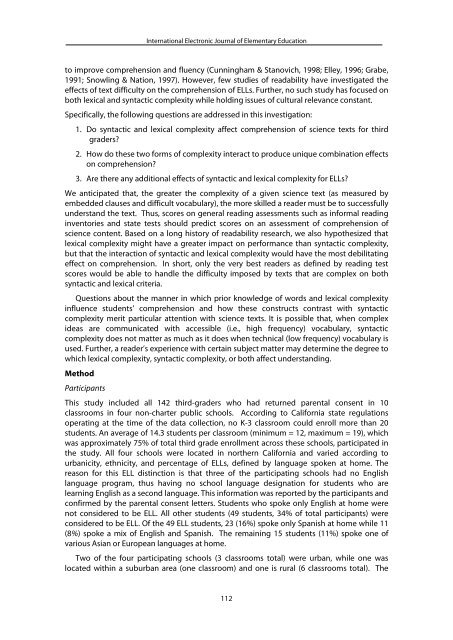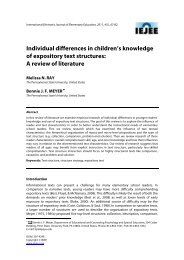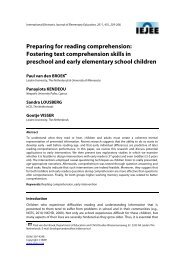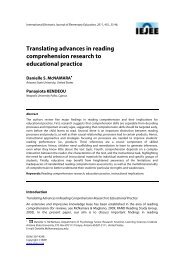The effects of syntactic and lexical complexity on the comprehension ...
The effects of syntactic and lexical complexity on the comprehension ...
The effects of syntactic and lexical complexity on the comprehension ...
Create successful ePaper yourself
Turn your PDF publications into a flip-book with our unique Google optimized e-Paper software.
Internati<strong>on</strong>al Electr<strong>on</strong>ic Journal <str<strong>on</strong>g>of</str<strong>on</strong>g> Elementary Educati<strong>on</strong>to improve comprehensi<strong>on</strong> <str<strong>on</strong>g>and</str<strong>on</strong>g> fluency (Cunningham & Stanovich, 1998; Elley, 1996; Grabe,1991; Snowling & Nati<strong>on</strong>, 1997). However, few studies <str<strong>on</strong>g>of</str<strong>on</strong>g> readability have investigated <strong>the</strong><str<strong>on</strong>g>effects</str<strong>on</strong>g> <str<strong>on</strong>g>of</str<strong>on</strong>g> text difficulty <strong>on</strong> <strong>the</strong> comprehensi<strong>on</strong> <str<strong>on</strong>g>of</str<strong>on</strong>g> ELLs. Fur<strong>the</strong>r, no such study has focused <strong>on</strong>both <str<strong>on</strong>g>lexical</str<strong>on</strong>g> <str<strong>on</strong>g>and</str<strong>on</strong>g> <str<strong>on</strong>g>syntactic</str<strong>on</strong>g> <str<strong>on</strong>g>complexity</str<strong>on</strong>g> while holding issues <str<strong>on</strong>g>of</str<strong>on</strong>g> cultural relevance c<strong>on</strong>stant.Specifically, <strong>the</strong> following questi<strong>on</strong>s are addressed in this investigati<strong>on</strong>:1. Do <str<strong>on</strong>g>syntactic</str<strong>on</strong>g> <str<strong>on</strong>g>and</str<strong>on</strong>g> <str<strong>on</strong>g>lexical</str<strong>on</strong>g> <str<strong>on</strong>g>complexity</str<strong>on</strong>g> affect comprehensi<strong>on</strong> <str<strong>on</strong>g>of</str<strong>on</strong>g> science texts for thirdgraders?2. How do <strong>the</strong>se two forms <str<strong>on</strong>g>of</str<strong>on</strong>g> <str<strong>on</strong>g>complexity</str<strong>on</strong>g> interact to produce unique combinati<strong>on</strong> <str<strong>on</strong>g>effects</str<strong>on</strong>g><strong>on</strong> comprehensi<strong>on</strong>?3. Are <strong>the</strong>re any additi<strong>on</strong>al <str<strong>on</strong>g>effects</str<strong>on</strong>g> <str<strong>on</strong>g>of</str<strong>on</strong>g> <str<strong>on</strong>g>syntactic</str<strong>on</strong>g> <str<strong>on</strong>g>and</str<strong>on</strong>g> <str<strong>on</strong>g>lexical</str<strong>on</strong>g> <str<strong>on</strong>g>complexity</str<strong>on</strong>g> for ELLs?We anticipated that, <strong>the</strong> greater <strong>the</strong> <str<strong>on</strong>g>complexity</str<strong>on</strong>g> <str<strong>on</strong>g>of</str<strong>on</strong>g> a given science text (as measured byembedded clauses <str<strong>on</strong>g>and</str<strong>on</strong>g> difficult vocabulary), <strong>the</strong> more skilled a reader must be to successfullyunderst<str<strong>on</strong>g>and</str<strong>on</strong>g> <strong>the</strong> text. Thus, scores <strong>on</strong> general reading assessments such as informal readinginventories <str<strong>on</strong>g>and</str<strong>on</strong>g> state tests should predict scores <strong>on</strong> an assessment <str<strong>on</strong>g>of</str<strong>on</strong>g> comprehensi<strong>on</strong> <str<strong>on</strong>g>of</str<strong>on</strong>g>science c<strong>on</strong>tent. Based <strong>on</strong> a l<strong>on</strong>g history <str<strong>on</strong>g>of</str<strong>on</strong>g> readability research, we also hypo<strong>the</strong>sized that<str<strong>on</strong>g>lexical</str<strong>on</strong>g> <str<strong>on</strong>g>complexity</str<strong>on</strong>g> might have a greater impact <strong>on</strong> performance than <str<strong>on</strong>g>syntactic</str<strong>on</strong>g> <str<strong>on</strong>g>complexity</str<strong>on</strong>g>,but that <strong>the</strong> interacti<strong>on</strong> <str<strong>on</strong>g>of</str<strong>on</strong>g> <str<strong>on</strong>g>syntactic</str<strong>on</strong>g> <str<strong>on</strong>g>and</str<strong>on</strong>g> <str<strong>on</strong>g>lexical</str<strong>on</strong>g> <str<strong>on</strong>g>complexity</str<strong>on</strong>g> would have <strong>the</strong> most debilitatingeffect <strong>on</strong> comprehensi<strong>on</strong>. In short, <strong>on</strong>ly <strong>the</strong> very best readers as defined by reading testscores would be able to h<str<strong>on</strong>g>and</str<strong>on</strong>g>le <strong>the</strong> difficulty imposed by texts that are complex <strong>on</strong> both<str<strong>on</strong>g>syntactic</str<strong>on</strong>g> <str<strong>on</strong>g>and</str<strong>on</strong>g> <str<strong>on</strong>g>lexical</str<strong>on</strong>g> criteria.Questi<strong>on</strong>s about <strong>the</strong> manner in which prior knowledge <str<strong>on</strong>g>of</str<strong>on</strong>g> words <str<strong>on</strong>g>and</str<strong>on</strong>g> <str<strong>on</strong>g>lexical</str<strong>on</strong>g> <str<strong>on</strong>g>complexity</str<strong>on</strong>g>influence students’ comprehensi<strong>on</strong> <str<strong>on</strong>g>and</str<strong>on</strong>g> how <strong>the</strong>se c<strong>on</strong>structs c<strong>on</strong>trast with <str<strong>on</strong>g>syntactic</str<strong>on</strong>g><str<strong>on</strong>g>complexity</str<strong>on</strong>g> merit particular attenti<strong>on</strong> with science texts. It is possible that, when complexideas are communicated with accessible (i.e., high frequency) vocabulary, <str<strong>on</strong>g>syntactic</str<strong>on</strong>g><str<strong>on</strong>g>complexity</str<strong>on</strong>g> does not matter as much as it does when technical (low frequency) vocabulary isused. Fur<strong>the</strong>r, a reader’s experience with certain subject matter may determine <strong>the</strong> degree towhich <str<strong>on</strong>g>lexical</str<strong>on</strong>g> <str<strong>on</strong>g>complexity</str<strong>on</strong>g>, <str<strong>on</strong>g>syntactic</str<strong>on</strong>g> <str<strong>on</strong>g>complexity</str<strong>on</strong>g>, or both affect underst<str<strong>on</strong>g>and</str<strong>on</strong>g>ing.MethodParticipantsThis study included all 142 third-graders who had returned parental c<strong>on</strong>sent in 10classrooms in four n<strong>on</strong>-charter public schools. According to California state regulati<strong>on</strong>soperating at <strong>the</strong> time <str<strong>on</strong>g>of</str<strong>on</strong>g> <strong>the</strong> data collecti<strong>on</strong>, no K-3 classroom could enroll more than 20students. An average <str<strong>on</strong>g>of</str<strong>on</strong>g> 14.3 students per classroom (minimum = 12, maximum = 19), whichwas approximately 75% <str<strong>on</strong>g>of</str<strong>on</strong>g> total third grade enrollment across <strong>the</strong>se schools, participated in<strong>the</strong> study. All four schools were located in nor<strong>the</strong>rn California <str<strong>on</strong>g>and</str<strong>on</strong>g> varied according tourbanicity, ethnicity, <str<strong>on</strong>g>and</str<strong>on</strong>g> percentage <str<strong>on</strong>g>of</str<strong>on</strong>g> ELLs, defined by language spoken at home. <str<strong>on</strong>g>The</str<strong>on</strong>g>reas<strong>on</strong> for this ELL distincti<strong>on</strong> is that three <str<strong>on</strong>g>of</str<strong>on</strong>g> <strong>the</strong> participating schools had no Englishlanguage program, thus having no school language designati<strong>on</strong> for students who arelearning English as a sec<strong>on</strong>d language. This informati<strong>on</strong> was reported by <strong>the</strong> participants <str<strong>on</strong>g>and</str<strong>on</strong>g>c<strong>on</strong>firmed by <strong>the</strong> parental c<strong>on</strong>sent letters. Students who spoke <strong>on</strong>ly English at home werenot c<strong>on</strong>sidered to be ELL. All o<strong>the</strong>r students (49 students, 34% <str<strong>on</strong>g>of</str<strong>on</strong>g> total participants) werec<strong>on</strong>sidered to be ELL. Of <strong>the</strong> 49 ELL students, 23 (16%) spoke <strong>on</strong>ly Spanish at home while 11(8%) spoke a mix <str<strong>on</strong>g>of</str<strong>on</strong>g> English <str<strong>on</strong>g>and</str<strong>on</strong>g> Spanish. <str<strong>on</strong>g>The</str<strong>on</strong>g> remaining 15 students (11%) spoke <strong>on</strong>e <str<strong>on</strong>g>of</str<strong>on</strong>g>various Asian or European languages at home.Two <str<strong>on</strong>g>of</str<strong>on</strong>g> <strong>the</strong> four participating schools (3 classrooms total) were urban, while <strong>on</strong>e waslocated within a suburban area (<strong>on</strong>e classroom) <str<strong>on</strong>g>and</str<strong>on</strong>g> <strong>on</strong>e is rural (6 classrooms total). <str<strong>on</strong>g>The</str<strong>on</strong>g>112





